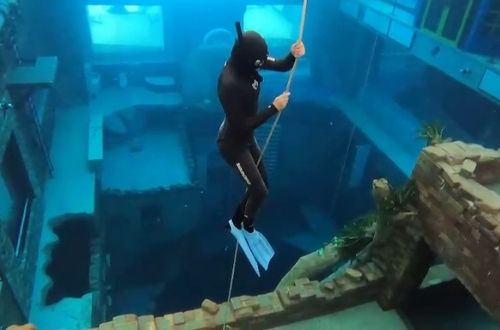Introduction
As we saw in an article published last year, contrary to some popular beliefs, as long as we are relaxed, air travels naturally from the lungs to the mouth, regardless of whether we are head up or head down. The main reason is that the lungs are much more flexible than the head and the oral cavity. Therefore, the external pressure is released first in the lungs, and the air travels in the direction “high pressure to low pressure”. For more details, I invite you to read or re-read this article.
However, this demonstration does not explain a phenomenon that most freedivers have observed: it is easier to equalize when “head up.”
In this article, I will present the two explanations that I believe to be the most relevant to explain this phenomenon for the Frenzel equalization. You may already be familiar with the first of these explanations. The second one is the result of my work on the subject, and I have never heard it formulated by anyone else. However, a hyperbaric doctor (Dr. Heikal) has confirmed its relevance.
A little reminder
Before going any further, let’s look at the mechanics of equalization. An equalization (except BTV) consists of generating pressure at the entrance of the eustachian tubes to open them. Once opened, air naturally comes to lodge in the middle ear. The amount of pressure you have to generate you may know if you have already used an EQ tool (not an otovent). As an indication, we can consider an average of this value at about 30 millibars (this value is not definitive, and there are several ways to decrease it, starting with good hydration). Nevertheless, it is essential to understand that this value is not absolute. It is 30 millibar PLUS the ambient pressure. It means that if I am in a hyperbaric chamber with 2 bars, 3 bars, or 10 bars of ambient pressure, I should always generate 30 millibars of additional pressure to open my tubes.
Explanation 1: more blood pressure head down
Our blood is subject to gravity, and when we are head down, the blood pressure towards our head increases. The eustachian tubes being flexible enough, they accumulate more blood. It makes them “heavier,” and we need more pressure to open them. To better understand this, you can think of the eustachian tubes as swinging doors that you have to push open. The heavier a door is, the more force and pressure you need to generate to open it. This extra pressure to generate makes equalization head down more difficult.
Explanation 2: higher ambient pressure when we are “head up”.
Let’s imagine a head down diver whose head is at precisely 10 m depth and whose abdominal area is 9.5 m. As we explained in the introduction, the head does not deform under pressure and therefore cannot reproduce the external pressure. Thus the “natural” pressure in the oral cavity will be 1.95 bar. If our diver goes head up while keeping his head at a depth of 10m, his abdominal area is now at a depth of 10.5m, and the “natural” pressure in the oral cavity increases to 2.05 bar. It gives us an extra theoretical ambient pressure difference of 0.1 bar. “Theoretical” because two mechanisms that are difficult to quantify and that I will not detail here largely attenuate this value. Nevertheless, we are in order of magnitude comparable to the 0.03 bar (30 millibars, remember) that we need to equalize. So to use the analogy of the swinging door, it’s as if you had a strong wind pushing against this door all the time, so you need to generate less force to open it.
A little perspective
For those who have trouble picturing all these values and who may not realize how much of an impact a 50 cm (estimated sternum to head) water gap can have (it is REALLY easier to equalize head up), it may be interesting to ask ourselves how many meters this pressure gap represents in the open air, at the surface… 500 meters! In terms of pressure, a 50cm water column is similar to a 500m air column. In terms of pressure again, 1m75 of water (size of a human) represents about 1750m of air. Yes, this is a lot, and it shows us how necessary it is to look at how external pressure is exerted on the different parts of the body if we want to understand equalization.
What applications?
The first and main application is to feed the curiosity of those who like to understand “how things work” and that is by itself lot in my opinion.
However, we can find a pedagogical application:
Personnally, since few months, once a beginner student is comfortable with the head-up equalization, rather than doing a head-down “test” or adding depth to make him go deeper head-up, I keep the line at the same depth while instructing him to generate more pressure in his equalization, to be a little more “aggressive”. It allows to simulate the subsequent dives the student will have to make in comfort and, it constitutes an intermediate step increasing the chance of success for head down dives.

